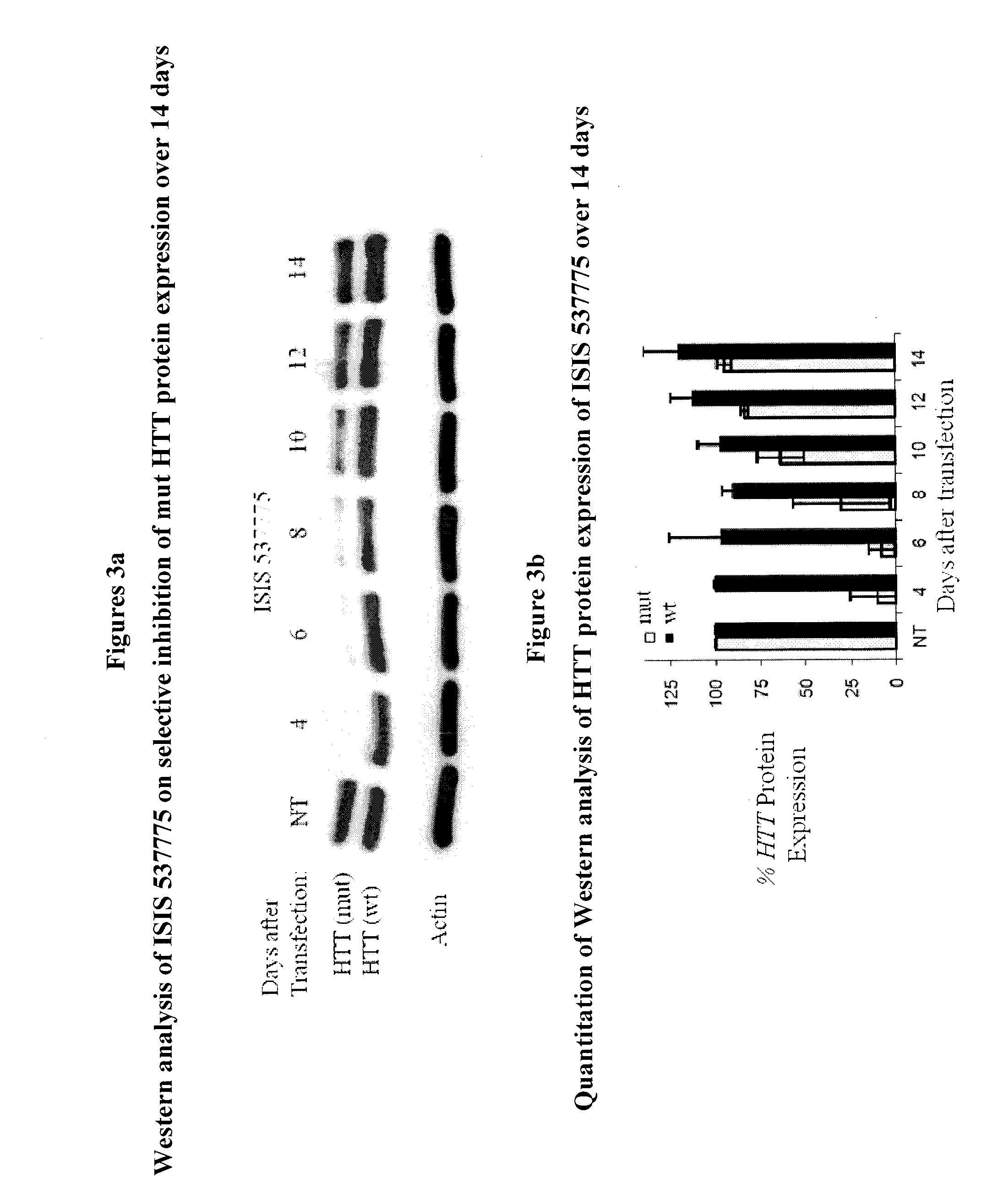Methods and compounds useful in conditions related to repeat expansion
a repeat expansion and compound technology, applied in the field of chemically modified oligonucleotides, can solve the problems of repeat-containing rna molecules disrupting the cell, increasing the number of repeating units, etc., and achieve the effect of reducing the activity or amount of proteins and reducing the amount or activity of proteins
- Summary
- Abstract
- Description
- Claims
- Application Information
AI Technical Summary
Benefits of technology
Problems solved by technology
Method used
Image
Examples
example 1
Modified Single Stranded RNAs (ssRNAs) Targeting Huntingtin (HTT) CAG Repeat Region ssRNAs, siRNAs and Gapmers
[0587]A series of modified single strand RNAs (ssRNAs) were designed and tested for their ability to selectively inhibit mutant (mut) HTT protein expression levels in patient-derived fibroblast cell line GM04281 (69 CAG repeats mutant / 17 CAG repeats wild-type). The potency and selectivity of the modified ssRNAs were evaluated and compared to the gapmers and the double stranded small interfering RNAs (siRNAs).
[0588]The gapmers comprising a 5-10-5 motif were prepared using the procedures as described above and the siRNAs were purchased from Integrated DNA Technologies (IDT, Coralville, Iowa).
[0589]The modified ssRNAs, siRNAs and gapmers are described in Table 1. A subscript “s” between two nucleosides indicates a phosphorothioate internucleoside linkage (going 5′ to 3′). The absence of a subscript “s” between two nucleosides indicates a phosphodiester internucleoside linkage. ...
example 2
Modified Single Stranded RNAs (ssRNAs) Targeting Ataxin-3 (ATXN-3) CAG Repeat Region
[0596]The modified ssRNAs from Table 1, ISIS 537775, ISIS 537786, and ISIS 537787 were selected and tested for their ability to selectively inhibit mutant ATXN-3 protein expression levels. The modified ssRNAs were tested in the GM06151 cell line (74 CAG repeats mutant / 24 CAG repeats wild-type). Cultured GM06151 cells at a density of 60,000 cells per well were transfected using lipid RNAiMAX (Invitrogen) with 0.2, 0.6, 1.8. 5.6, 16.7, 50 and 100 nM concentrations of ssRNAs. Typically 4 μL of lipid per well is used for transfection at 100 nM in accordance to manufacturer's protocol. Media containing RNA and lipid are mixed and allowed to sit for 20 minutes for complex formation, and the lower doses are obtained by way of serial dilution at 1:2 or 1:3-fold. Media was exchanged 1 day after transfection with fresh supplemented MEM. Cells were washed with phosphate-buffered saline and harvested 4 days afte...
example 3
Evaluation of Argonaute (Ago) Proteins in ssRNA-Mediated Inhibition of HTT Expression
[0599]Argonaute (Ago) proteins are critical mediators of RNAi. There are four Ago variants in human cells (Ago1-4), with Ago2 being the best characterized. Ago2 promotes association of RNA with complementary mRNA sequences and can induce cleavage of the mRNA target. To examine the potential for Argonaute to mediate action of ssRNAs, effects of reducing cellular Ago levels on inhibition of HTT expression by ssRNAs and siRNAs were evaluated.
[0600]The modified ssRNAs and siRNAs are described in Table 4. A subscript “s” between two nucleosides indicates a phosphorothioate internucleoside linkage (going 5′ to 3′). The absence of a subscript “s” between two nucleosides indicates a phosphodiester internucleoside linkage. A “Pv” at the 5′-end indicates a 5′-(E)-vinylphosphonate group, (PO(OH)2(CH═CH—). A “Po” at the 5′-end indicates a 5′-phosphate (PO(OH)2—). Nucleosides without a subscript are β-D-2′-deoxy...
PUM
| Property | Measurement | Unit |
|---|---|---|
| Fraction | aaaaa | aaaaa |
Abstract
Description
Claims
Application Information
 Login to View More
Login to View More - R&D
- Intellectual Property
- Life Sciences
- Materials
- Tech Scout
- Unparalleled Data Quality
- Higher Quality Content
- 60% Fewer Hallucinations
Browse by: Latest US Patents, China's latest patents, Technical Efficacy Thesaurus, Application Domain, Technology Topic, Popular Technical Reports.
© 2025 PatSnap. All rights reserved.Legal|Privacy policy|Modern Slavery Act Transparency Statement|Sitemap|About US| Contact US: help@patsnap.com



